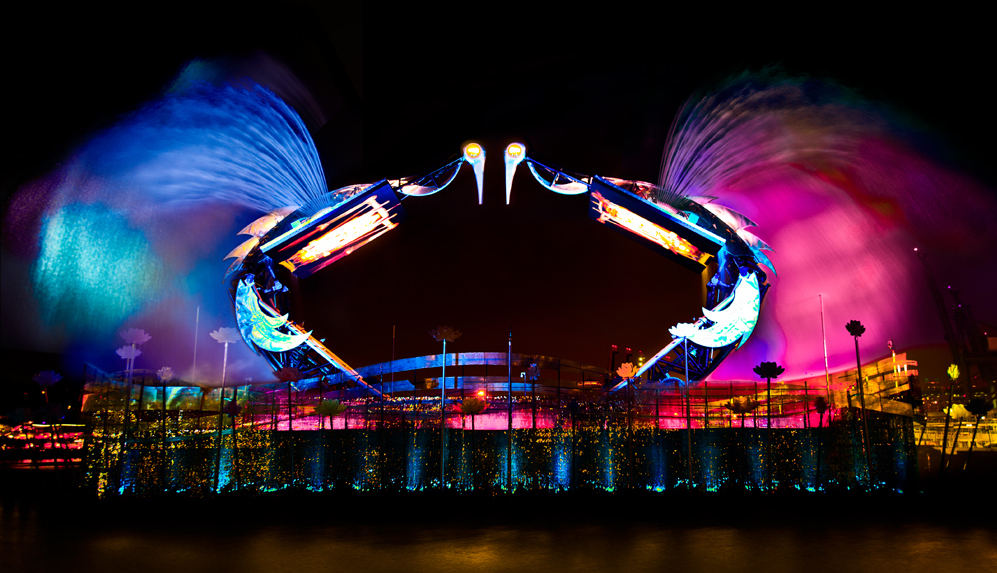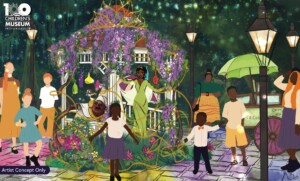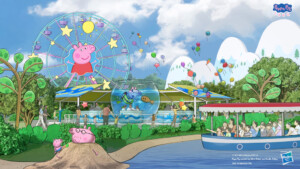Experts in the creation of high-technology guest experiences, The Producers Group (TPG) is making its presence felt in Asia.
With world-class projects under its belt at venues across the region including Chimelong Ocean Kingdom, China and Resorts World Sentosa, Singapore, the company has further consolidated its commitment to the Asian market with the opening of a new office in Shanghai.
 Blooloop invited TPG’s Co-CEOs Bob Chambers (right) and Edward Marks to share their insights and experiences of this fast-growing market.
Blooloop invited TPG’s Co-CEOs Bob Chambers (right) and Edward Marks to share their insights and experiences of this fast-growing market.
Bob Chambers began his career at Iwerks Entertainment, working closely with Disney Legends Don Iwerks and Bob Gurr. He has 20 years’ experience in the theme park and themed entertainment industry as a Producer, Project Manager and Technical Director and has been responsible for projects as diverse as The Fortune Diamond and Wishing Crystals attractions at the Galaxy Casino in Macau and the upgraded Revenge of the Mummy The Ride at Universal Studios Hollywood.
Edward Marks has produced and managed countless projects worldwide including Sci-Fi City, Crane Dance, Lake of Dreams and The Hall of Treasuresfor Resorts World Sentosa and the proposed Marvel City theme park in Dubai. Through his company, Marks Creative Inc., he has been involved in both technical and lighting design and development for a whole range of projects across America, the Middle East and Asia.
What is your view of the Asian market and how do you envisage it developing over the next 10 years?
The Asian market is at a fascinating crossroads where we are seeing every type of development imaginable. In some corners, there is an “anything goes” mentality, while some developers see the value in being aligned with a well-known western brand. The interest in China for growing the location based entertainment market will see deals reached with not only the major players such as Disney and Universal, but with many of the newer entrants into the arena such as 20th Century Fox, DreamWorks, and Paramount.
We have been encouraged to also see a lot of interest in “green” tourism, reflecting a desire to connect with nature, animals, and more peaceful recreation options across the region. We’ve consulted on zoos, aquariums, golf and other leisure destinations.
On the flip side, we are also always pushing the envelope to integrate new and unique technologies. Parks at large are dealing with adding mobile content, phone-driven interactivity, flexible payment programs, people tracking, and geo-tagging technologies, but the queue and in-ride experience is where we excel in helping developers and IP owners evolve the user experience.
Immersive media is playing a big role in a number of our recent projects. Whether it’s a vignette in the queue or the full 3D production for a dark ride, TPG has a unique mix of talent to bring to the table. In addition to our many collective years of theme parks and attractions work, many of our staff have film, TV, and live event experience. This allows us to blend cutting-edge technical design with production know-how to deliver the best possible product to fit each project. Developers in Asia and brand licensing representatives are always looking for the right bridge to carry off the creative intent while protecting both the brand and the bottom line of the budget for both sides of the investment. And when technology provides a new revenue stream for the attraction or venue, then everyone is excited.

Since we are constantly on active projects and in touch with the latest technologies from all disciplines, it’s easy for us to pull together the best solutions for both the design and implementation phases of any attraction. As vendors continue to develop new products, we will have to continue assessing when the fit is right. At the same time, the manufacturers in Asia are getting better all the time, so there are even more options to chose from when we consider sourcing for projects in China and beyond.
As we are seeing maturing of the Asian market place, we are also seeing the people who attend parks have greater expectations. Everyone talks about the level of guest experience and makes comparisons to Disney and Universal. We deal with this quite often. There are certain locations in the world and in Asia that have set a high bar. Tokyo Disneyland and Tokyo DisneySea are two of those locations. Even if a large percentage of Asian park-goers don’t see those parks, attractions developers in other parts of Asia still want to know how to get closer to that level of immersion and quality. Of course, over time, the bar will be set higher in places like China, precisely because of the new offerings by Disney in mainland. It will become the new standard to meet, and competition will naturally cause more theme park owners to contemplate a new level of spending and more experienced production planning.
 How much of the Producers Group business is in Asia and how has this been developed?
How much of the Producers Group business is in Asia and how has this been developed?
On average, about half of our work is in Asia at any given point. As with most aspects of our industry, the timelines ebb and flow, but we are fully committed to having a solid presence in the region. TPG has completed 12 attractions in the past 5 years, and have a couple of new projects currently in development. China is continuing to become a larger piece of the picture, but we’ve worked in Singapore, Macau, Hong Kong, Hengqin, Seoul, and Tokyo. We work very hard to get the word out about our unique process for production and design. It is paying off in greater interest from developers at our booth at IAAPA Asia each year. There is no substitute for having a quality service and product, and making a logical business case that there are real solutions available that achieve great results.
TPG has recently added a new office in Shanghai that is represented by five full-time staff. This is in addition to the Beijing sales office we have had for the past few years. That’s a pretty clear sign that we are serious about working in China, while also respecting the fact that our Chinese clients really need that immediate and relevant and local response from us. We want to make sure that we are respecting every culture we work in, and this is very important in China as both sides are still learning about each other with respect to the ways of conducting business in our industry.
Which recent projects have you been particularly proud of?
While every completed project is a source of pride we share with our clients and production partners, it was really nice to see Chimelong Ocean Kingdom receive the Thea Award for Outstanding Achievement, Theme Park at this year’s TEA Awards. TPG was part of four attractions in that park, and it really is a solid effort for an independent company to continue growing its brand. In addition to the Crane Dance at Resorts World Sentosa, this makes two Thea Award winners that TPG has been associated with in recent years.
.jpg)
It was exciting to be part of the collaboration between companies from the east and west working to make the attractions at Chimelong Ocean Kingdom as technically advanced as any park in China to date. The Chimelong Group knew what they wanted to create, but were open to input from western companies on both the creative and the process side. What we had to balance was: offering our opinions, but also not being so locked into those opinions that when the client chose to go a different way, we couldn’t let it go.
What challenges have you faced in working in Asia and how have you overcome them?
The smartest thing we have done was to hire the most talented locals we could find. This might take the form of someone who has some experience in entertainment, a knowledgeable vendor, or even just a very enthusiastic person. Since every location is going to have it’s unique challenges, we really look for that local contact who is going to help us identify the pros and cons as quickly as possible.
Our recent counterparts in Singapore, Macau, and Hengqin were stellar. And they were a mix of Asian and Western representations. We have had meetings with clients where no one on their side of the table spoke English and we had to rely on translators. That can be extremely challenging when discussing technical matters and legal matters. So we make sure we can make a very focused effort on those elements before we get too far down the line on any agreement.

Diplomacy is certainly as important as the skill of building attractions. There are a mix of desired outcomes, assumptions, target dates, ROIs, etc., that have to be taken into consideration to make sure that the schedule and the budget are sensible enough to allow for success. If a developer is too far downstream on a project, it can be incredibly difficult to pull them back from the brink. Gaining their trust is paramount to being able to have enough influence to reach agreements on changing a course of action if it’s in everyone’s best interest.
However, one area that TPG has excelled in is “rescuing” projects that got off to a rocky start. Sometimes a development doesn’t start effectively or there has been excessive Value Engineering, or perhaps the initial partners, vendors, or suppliers have failed to be contracted to cover all of the correct scope. We’ve been brought on to unravel these kinds of scenarios and we’ve found that if we just maintain our calm experienced analysis of the situation, that it can be relatively easy to get things back on track. It’s not always easy to get everyone to see things our way, but the largest majority of the time we are trusted to “land the plane” and wrangle the project to the desired completion.

With the overall charge towards being the “next big thing, ” we have seen a few developers start land works without master plans and we have also seen a bit of questionable IP development. Asia is a massive part of the globe, and China is a major player, so there are going to be intellectual property challenges to overcome. But with a culture that has completely different views on everything from brand ownership to construction safety, we hope with time that there will be more regard for these aspects as the market continues to thrive and mature.
Are there any key lessons learned for working in Asia that you can share?
On top of what we’ve said so far, being open to learning about each region or locale’s specific cultural traditions as well as their vision for the future will help you integrate your specific efforts into theirs. In essence, it’s really just taking the time to get to know them instead of shoehorning what you think is right into their world. This may seem really obvious, but we feel that it’s a must.
Just as you might adjust your attitude if you visit another city like New York, London, Paris, or Moscow, it might need to happen to a more significant extent in Asia. Even though Asian cultures have contributed amazing things to the globe in terms of technology, engineering, language, and art, there is a certain gap in know-how for Themed Entertainment. Perhaps it’s simply because of the Disney phenomenon that the West has the majority of the experience in the industry, but it is also part of our duty to share and deliver the heart of that legacy to the rest of the world.
Have there been any surprises with your projects in Asia?
While we have talked about being as culturally sensitive as possible, every project has its share of funny or shocking stories. One of the most obvious and glaring issues for us was the seeming lack of safety protocols on construction sites. While it was fascinating to watch a crew build a 100’ high bamboo scaffold, it was equally shocking to watch guys welding without masks. There is obviously a huge societal divide between the business owners and the labor pool, but it was a little unnerving to see the quality of work sites.

That being said, there are some amazing artists throughout Asia. We have seen some stunning work done at all scales and in many applications. Everything from rock and tile works, and wood carving, to sculpture, and landscaping. The attention to certain details that the typical park-goer will probably never even notice was awe-inspiring. If you do have a chance to get to Ocean Kingdom, take a moment to admire the concrete work on the lagoon ship. You’d swear it’s an ancient vessel that was made out of wood, but it is in fact totally created with concrete that has been hand detailed.
Have you any exciting new projects in the pipeline that you can tell us about?
We have the same problem that everyone else in the business has…being able to speak about what we are working on without violating non-disclosure agreements. As far as Asia is concerned, one of the biggest roles we have played is in our consulting role for 20th Century Fox. We’ve been working with them for a couple of years on everything from business strategy to attraction design. Most of this work has been focused on the new park being built at Genting Highlands, known as 20th Century Fox World. It’s been a lot of fun helping a massive brand with such a tremendous history enter the LBE landscape. Of course, that experience makes TPG the perfect match to help developers in Asia interested in IP-based attractions.
We have done some technical consulting, and several technical design packages and attractions designs for other companies throughout China, but nothing we can announce just yet!













